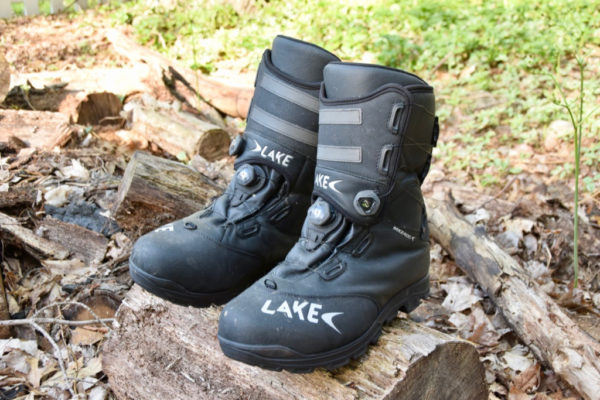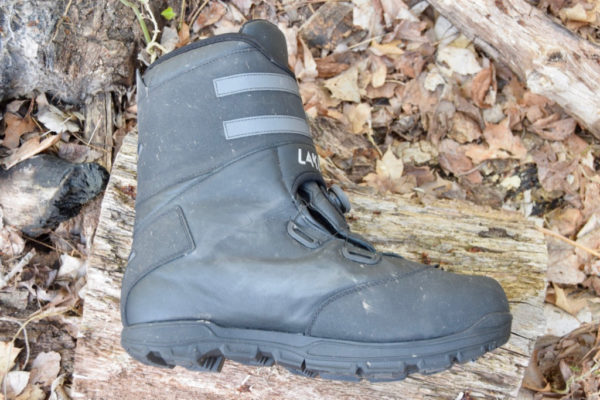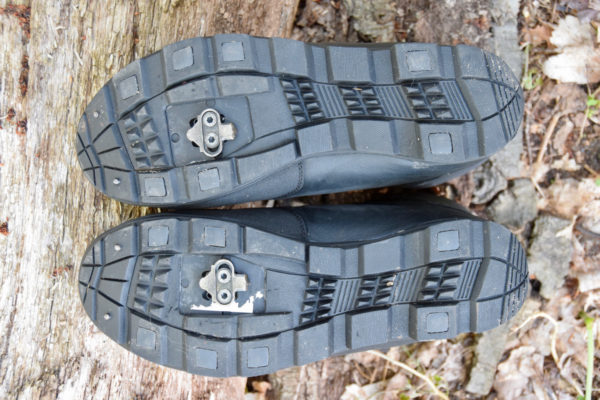
For those not familiar with the Lake MXZ400 it is Lake’s “winter extreme” cycling boot. It takes almost every aspect of Lake’s classic MXZ300 series boots and adds features that increase the warmth of the boot. In my “out of the box” write up I detail a lot of these features if you are interested in the specific details. Over the second half of the winter, I was able to put over 400 miles on these boots so I am at a point where I am starting to really know how well they perform across a range of conditions down to about zero degrees Fahrenheit. Unfortunately, we didn’t experience any days below zero since I got these boots (go figure).
I want to first start off with a general comment about how my mindset has shifted towards boots like this which are designed for “extreme cold.” I have ridden the first generation 45NRTH Wolvhammer since it was introduced. When I originally got those I was blown away by how much better they were than anything I had used previously and couldn’t really think of how I could need anything warmer. When companies like Lake and 45NRTH released their more “hardcore” winter boots (the MXZ400 and Wølfgar respectively) I just didn’t think they were necessary for the kind of riding I normally do because my old school Wolvhammers were good enough. Having the MXZ400’s to ride in has really opened my mind to the limitations I had put on myself. With the MXZ400 in my “quiver” of gear, it has allowed me to take on rides I would never have been able to previously and I cannot recommend enough that other fat bikers consider getting a super warm boot if you tend to have any issues at all with cold feet. Based on my conversations I think there are a lot of riders out there that may not realize how much a boot like this can help to make winter riding more enjoyable.

Getting into the specifics of my impressions of the MXZ400’s, durability has been excellent so far. There is some minor scuffing from the crank arms but it looks more like the aluminum from my crank arms discoloring the boots than the boots showing any signs of wear. The Boa system is still working flawlessly and never had any issues regardless of temperature or how stupid/unlucky I was. On one occasion with the air temps in the teens I broke through some ice while crossing a stream and found myself standing in water well above the Boas. I expected the Boas to freeze up but had no issues at all with them the rest of the ride. Waterproofing as a whole has also been excellent.
The one thing I have noticed with the upper Boa dial is that I need to be careful to keep it a little on the loose end otherwise my achilles tendons start to bug me. There were several times I would get an hour or so into a ride and notice my tendons were getting sore. Loosening the dials was easy to do even with gloves on and the pain went away quickly thereafter. I am chalking that up to user error/experience rather than a design flaw.

Another noteworthy thing to point out is the height of the cuff on the boot. I was able to get my hands on pairs of the new 45NRTH Wölvhammer (size 47) and Wølfgar (size 48) to take some pics of similar sized boots so you can see how they compare to the Lake MXZ400 (size 50). I wasn’t able to get my hands on a similarly sized Lake MXZ 303 (sorry!). It is worth noting that the cuff is significantly taller on the MXZ400 than the other boots. I have heard from some riders that the high cuff “doesn’t work for them” but for me they worked great and offer more protection from snow ingress. I didn’t have the forethought to drill down and find out what didn’t work for the other riders when I was talking to them. Regardless, this backs up the “try before you buy” adage so commonly attributed to footwear.

The outsoles are showing no signs of wear from walking nor from pedaling. There are two small spikes/studs in the toe of each boot. They are a nice addition but are pretty minimal. You can definitely get them to bite into ice when needed but I found myself consciously needing to make sure I was on my toes for them to do anything. If you are not thinking and put your foot down on glare ice they are probably not going to save from going down. The lighter colored squares in the sole are harder rubber than the surrounding and they did seem to offer some additional biting edges on rougher ice. It would be nice to see a more customizable option to add more studs and/or change the location so you could beef up your ice traction if desired.
Warmth has (as expected) been excellent. They are considerably warmer than my Wolvhammers, giving me a lot more time before my feet get cold. The only time my feet got cold at all while using the MXZ400’s was when I was on a group ride that started out way too hard for how much clothing I had on and got really sweaty. About 2-3 hrs into that ride I was cold all over (including my feet) and it made the last hour of the ride kind of miserable. Once again that says more about me being dumb than anything about the boots themselves. Outside of that one ride I got in a ton of short (1.5ish hrs) to medium (3 hrs) rides and even got in one monster ride that was about 7 hours long. That long ride had temps varying from single digits to upper 20’s and my feet were comfortable for the whole duration.
Pedaling efficiency has been as good as dedicated cycling footwear should be. The soles feel stiff but are still really comfortable to walk or hike-a-bike in. I was a bit worried the height of the cuff my restrict movement when walking but the tall cuffs of the boot were comfortable and didn’t seem to restrict movement when walking. They certainly do a great job of keeping snow from entering the top of the boot.

The top insole showing “scrunching” by the toes and the bottom one “scrunching” by the heals.
The only real complaint I have so far concerns the insoles of the boot. On a couple occasions, they have scrunched up inside the boots after 3+ hours of riding. I don’t remember doing anything weird/different to cause that to happen. I think it may just be due to the way the insoles are made and/or possibly because the boots I amusing are a size or two bigger than what I would normally wear. The insoles are pretty flexible and are not really contoured to the shape of a foot so I think they are just more prone to movement/scrunching in the boot. Next winter I am going to try putting an additional aftermarket insole on top of the stock insole to see if that may help. My hope is that I will be able to retain the insulating properties of the stock insole but with a more rigid aftermarket insole like Superfeet or eSoles keeping things more in place.
If you are in the market for cycling boots that can handle really low temperatures, I can highly recommend the Lake MXZ400. I would also advocate for any fat biker to consider getting a more burly boot like this over the more common options like the MXZ303 and Wolvhammer if you commonly get cold feet. My experience is that there is more to gain than lose by going with the warmer boot option. The MXZ400’s are a very well designed and constructed boot that can open up a world of winter adventure opportunities by keeping you nice and toasty.
For more about Lake Cycling visit – https://lakecycling.com/

It must be KBS Week here @ Fat-Bike.com and I like it! Kinda like Shark Week, but different.